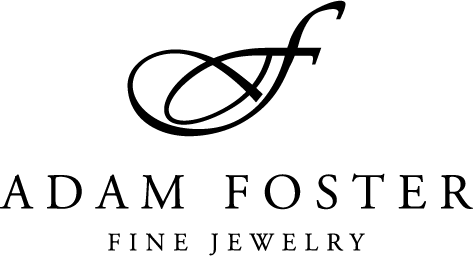Diamond Education: The 4 C's
A Buying Guide
At Adam Foster Fine Jewelry, we know that while every diamond is unique, there is a shared language for each individual diamond’s value and character. That language begins with the 4 Cs of diamonds: Cut, Color, Clarity, and Carat Weight.
What are the 4 Cs?
Developed by the Gemological Institute of America (GIA), the diamond 4Cs offer a universal grading system to assess a diamond’s quality, beauty, and worth. Understanding the 4 Cs provides the foundation for finding the perfect diamond.
If you are selecting a diamond engagement ring for someone special, or simply learning more about fine diamond jewelry, come to our studio in the heart of St. Louis to get hands-on knowledge and ask your questions.
Each diamond we source is accompanied by a GIA grading report, offering a clear, expert-backed assessment of the stone’s characteristics. But beyond the report, we help our clients see what really matters: how the diamond makes you feel, and how it tells your story.
Cut
Of all the Cs, diamond cut has the greatest impact on a diamond’s overall appearance. It defines how a diamond interacts with light and how much it sparkles. It is often mistaken for “shape,” like round or marquise; however, the cut is about how the diamond’s facets are angled and proportioned to produce maximum reflection.
Its cut grade—ranging from poor cut to excellent cut—reflects the diamond’s symmetry, proportions, and polish. For example, a well-cut diamond will show exceptional scintillation, brilliance, and fire.
So, whether you’re drawn to a classic round brilliant diamond or a more modern brilliant cut, a masterfully cut diamond will always stand out, regardless of its carat weight or color grade.

Color
Diamond color refers to the presence or absence of color within the stone. The GIA color scale ranks diamonds from D (completely colorless) to Z (noticeable yellow or brown tones).
-
Colorless diamonds (D–F) are prized for their icy clarity.
-
Near colorless diamonds (G–J) still appear white to the naked eye, especially when well-set.
-
Beyond J, a diamond begins to show warm undertones, which may or may not appeal depending on personal taste.
It’s important to note that this scale applies to white diamonds. Color diamonds—like yellows or blues—follow a different grading process.
At Adam Foster, our jewelers can help you explore a range of diamond color options, balancing beauty, the value of a diamond, and your budget.

Clarity
No two diamonds are completely alike, and clarity is where their unique fingerprint becomes visible. This C refers to the presence of inclusions (internal characteristics) and blemishes (external marks) formed naturally over millions of years.
Graded under 10x magnification, the clarity scale runs from flawless and internally flawless, through levels like VVS1, VVS2, and down to I1–I3, where inclusions may be more noticeable.
While flawless diamonds are exceedingly rare, many inclusions are microscopic and invisible to the naked eye. A clarity grade like VS1 or SI1 often offers excellent diamond quality with greater affordability.
Whether you’re selecting lab-grown diamonds or natural diamonds, our expert gemologists help you find diamond clarity that balances visual appeal with your personal taste.

Carat Weight
The final C, carat weight, measures the weight of a diamond, not just its visual size. One carat equals 200 milligrams. However, the diamond carat weight can appear differently depending on the diamond shapes and how the weight is distributed.
A round brilliant may carry its weight in depth, while an oval or marquise shape can appear larger at the same weight. Additionally, two diamonds with identical carat weight may look quite different if one is poorly cut and the other is perfectly proportioned.
For couples considering wedding rings or engagement rings, we guide you through carat options to find a stone that suits your style, finger, and setting without compromising brilliance.

Shape
Shape is not technically one of the four Cs, but it plays a vital role in the diamond’s appearance and how it complements your hand or setting. The most popular shape forever remains the round brilliant because of its classic look, but we see brides choose interesting shapes like briolette, cushion, asscher, and more.
Each shape interacts differently with light and has its own character. Some maximize sparkle while others elongate the finger or offer a vintage aesthetic.
Let your preference lead the way, and we’ll help you select a shape that resonates.

Natural vs. Lab-Grown
Both natural diamonds and lab-grown diamonds can be graded using the same GIA standards. The 4 Cs apply to both, with diamond grading based on the same metrics and grading scale. Lab-grown diamonds offer an ethical and budget-friendly alternative while still delivering stunning brilliance and beauty.
Finding the Right Balance
There is no universal formula for choosing the ideal diamond. The perfect diamond is the one that fits your vision. You may prefer a slightly larger carat with a near colorless tone. Or you may choose a well-cut diamond with a slightly lower clarity that still looks radiant to the naked eye.
Our team of jewelers will walk you through each step, explaining what each detail means and how it fits into your personal buying journey. Whether you're drawn to a VVS2 clarity or enchanted by a stone with excellent cut, we are here to guide you toward a diamond that speaks in your own language.

